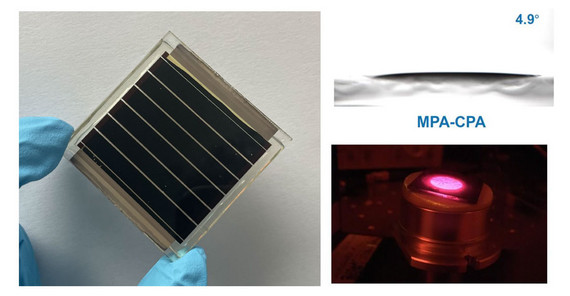Improving the lifetime energy yield from solar cells is an important factor to become independent from fossil energy sources. Inverted perovskite solar cells are particularly promising because of their very simple fabrication at low costs and their stability allowing them to pass several stability tests of the International Electrotechnical Commission (IEC). In contrast to solar cells with a regular structure, inverted perovskite solar cells resemble organic solar cells, with a layer of perovskite replacing the organic absorber layer. Novel charge transport materials that lower interfacial losses have to be developed to further reduce device degradation, enable upscaling and to further enhance the lifetime energy yield.
Fangyuan Ye, long-time PhD student visitor at the University of Potsdam from the East China University of Science and Technology (ECUST) and shared-first author, Prof. Dieter Neher and Dr. Martin Stolterfoht, leader of the PotsdamPero group and corresponding author, contributed to the study in which the authors developed a novel hole transport layer based on a self-assembled monolayer. This monolayer consists of amphiphilic molecules, molecules that are both hydrophilic (water-soluble) and hydrophobic (water-fearing). “The newly developed amphiphilic molecules provide a superwetting underlayer for the perovskite layer. This improves the morphology and crystallization of the perovskite at the buried interface to the hole transport layers which reduces interfacial recombination losses” explains Martin Stolterfoht.
The resulting perovskite films are very emissive (emitting 17% of the incoming light under open-circuit) and enabled record perovskite solar cells with a certified efficiency of 25.4%. In addition, 10 square centimeters mini modules delivered efficiencies of 22.0% with remarkable stability under both operational and damp heat test conditions.
Link to Publication: Shuo Zhang et al., Minimizing buried interfacial defects for efficient inverted perovskite solar cells. Science 380, 404-409 (2023). https://www.science.org/doi/10.1126/science.adg3755, DOI: 10.1126/science.adg3755
Image: Left: mini module. Upper right: contact angle of the perovskite solution on the self assembled monolayer. Lower right: PL emission of a perovskite film. Image Credit: Yongzhen Wu and Martin Stolterfoht.
Contact:
Dr. Martin Stolterfoht, Institute of Physics and Astronomy
Phone: +49 331 977 5638
E-Mail: martin.stolterfohtuuni-potsdampde
Media Information 28-04-2023 / Nr. 043

